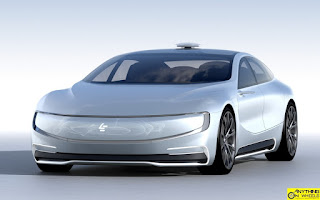Thanks to Flipkart and those multiple full page adverts in leading newspapers, most of us Indians need no introduction of LeTV, one of the many new smartphone makers from China to have landed on Indian soil. But not many are aware this Chinese tech company, that recently re-branded itself as 'LeEco', has an interest in automobiles too.
If you're wondering how, LeEco made headlines earlier this year with its investments in Faraday Future, an electric car start-up that made a splash of its own at the Consumer Electronics Show in Las Vegas, and partnership with Aston Martin to jointly develop the RapidE electric luxury sedan.
That doesn't make LeEco an aspiring automaker, does it? Ah well, put an end to such thoughts right away! Just look at the brand's own electric car concept 'LeSEE' below and you will know why we said that.
Sleek, futuristic and minimalist aren't words that we generally use when discussing the design and styling of Chinese cars. LeSEE makes us use all that and more. Used to seeing cars with thick chrome grilles and air dams, the LeSEE's fascia might appear bland to most trained eyes out there. But then, Tesla has made us immune to bland-faced cars. Coming back to the LeSEE, it's the car's gorgeous profile and the sexy rear that impressed us a lot. We know this is just a concept and there is absolutely nothing to read into it. Still, the LeSEE is one impressive automobile.
With suicide doors at the rear, touchscreens at the front and the rear, a steering wheel that can be folded down when not in use, rear seats that can apparently adapt to the shape of passenger's bodies and the capability of providing isolated environments for each passenger, LeSEE's interiors scream 'concept car crazy'. LeEco even has ideas to incorporate automated driving, self-learning, face recognition and a whole lot of stuff in the LeSEE along with grand plans to have a fleet of autonomous taxis based on this car. Now you know why the car is called LeSEE, the last three alphabets standing for Super Electric Ecosystem.
At the moment, this is just a tech company formally announcing its intentions to make it big in the automotive industry. Neither the car's specifications nor a firm launch timeline has been announced. But, if the short demo that LeEco showed a packed audience at an event in Beijing last month is any indication, the LeSEE looks good as it is and there is no reason why this can't be developed into a full-fledged mass-production electric car with a whole ecosystem to support its existence.
Tesla, Google and a handful of established automakers including Toyota, General Motors, Ford, Daimler, Jaguar and Land Rover are already moving ahead in the path of electric cars, autonomous capabilities, car-to-car connectivity and smart mobility solutions. Has LeEco got what it takes to fight with the biggies and convert the impressive LeSEE from concept to production? We hope it does, just to see the beautiful LeSEE roam on public roads!

















